This is the Minicord, a 16mm subminiature twin lens reflex camera made by Optische Anstalt C. P. Goerz in Vienna, Austria between the years 1951 and 1958. The Minicord shoots 10mm x 10mm exposures on double perforated 16mm cinema film loaded in reloadable cassettes designed specifically for this camera. The Goerz Minicord is a true TLR with a viewfinder lens coupled to the taking lens. The Minicord is of unusually high quality for a 16mm subminiature camera featuring a sharp 6-element 25mm f/2 lens, a well made all metal body, a 6-speed focal plane shutter, and a unique trigger film advance system. Although produced for several years, the camera was made in low numbers and is rare today.
Film Type: 16mm Double Perforated film (10mm x 10mm exposures on reloadable cassettes)
Lens: 2.5cm f/2 Goerz Helgor coated 6-elements in 4-groups
Focus: 0.4 meters to Infinity
Viewfinder: Coupled Reflex Viewfinder
Shutter: Vertically Traveling Focal Plane
Speeds: B, 1/10 – 1/400 seconds
Exposure Meter: None
Battery: None
Flash Mount: 1/4″ Threaded Pin Built Into Tripod Socket
Other Features: None
Weight: 336 grams
Manual: https://www.cameramanuals.org/pdf_files/minicord.pdf
How these ratings work |
The Goerz Minicord is a one of a kind subminiature 16mm TLR camera. It was made in Austria by a branch of the original Goerz company and is of very high quality with a sharp 6-element f/2 Goerz Helgor lens. The camera has a strange shape but excellent ergonomics, allowing for easy one handed operation. This being a true TLR design, the viewing lens is coupled with the taking lens, making focusing of the small camera very easy. The sharp Goerz lens makes good use of the tiny 10mm x 10mm images, offering good sharpness and quality. There were very few cameras of this design ever made, so whether you are a collector of 16mm cameras or TLRs, the Goerz Minicord is one that’s worthy of being added to any collection. | ||||||
| Images | Handling | Features | Viewfinder | Feel & Beauty | History | Age | |
| 1 | 2 | 1 | 1 | 2 | 2 | 30% | |
| Bonus | +1 for one of a kind design | ||||||
| Final Score | 12.7 | ||||||
History
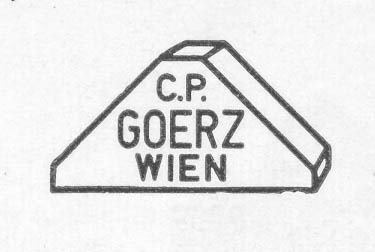 The firm of C.P. Goerz gets its name from Carl Paul Goerz, born on July 21, 1854 in Berlin. At the age of 17, he was an apprentice at the lens making firm Emil Busch AG in Rathenow whose history dates back to 1801. Three years later, he would move to Paris and work for Eugen Krauss first in technical sales and later working his way up to a lesser partner in the firm.
The firm of C.P. Goerz gets its name from Carl Paul Goerz, born on July 21, 1854 in Berlin. At the age of 17, he was an apprentice at the lens making firm Emil Busch AG in Rathenow whose history dates back to 1801. Three years later, he would move to Paris and work for Eugen Krauss first in technical sales and later working his way up to a lesser partner in the firm.
In 1886, at the age of 32, Goerz would move back to Berlin to start up his own company. In his first couple years, Goerz’s business was in mathematical tools and drawing apparatus, but he would eventually expand to include cameras.
In 1888, Goerz would absorb the camera workshop of F.A. Hintze and in 1890 would change names to Optische Anstalt C.P. Goerz. Around this time, Goerz employed an engineer named Carl Moser and an optical mechanic named Karl Hertel who would help the company develop its own line of lenses. The first lenses produced by Goerz were copies of the Rapid Rectilinear lens which were sold under the name Paraplanat and Lynkeioskop. Around 1892, Goerz would produce a Double Anastigmat lens which they called the Dagor, which is an abbreviation for Double Anastigmat GOeRz. The Dagor would quickly become the company’s flagship lens and would lead the company to prominence in Germany around the turn of the century.
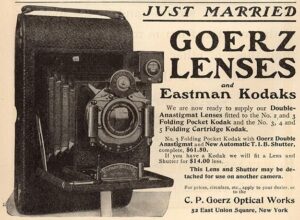
The company would expand and in 1895 would open its first American branch in New York which would eventually be called C.P. Goerz American Optical Company. At first, the New York office acted as distributor, but in 1902 would begin manufacturing Goerz products as well. Over the next few years, additional Goerz locations would open in London (1899), St. Petersburg (1905), and in Vienna (1909).
In the early 20th century, Goerz would see tremendous growth, employing as many as 10,000 workers by 1917. Goerz the most well organized and successful German lens maker, second only to Zeiss and seen as their primary competitor.
The first world war took its toll on Germany industries and the economy resulting in a recession by the 1920s which caused many companies to struggle. Limping along for the next several years, in 1926 the German government would step in and mandate a merger of several of Germany’s biggest optics companies into a single entity, known as Zeiss-Ikon. Goerz, along with ICA, Ernemann, and Contessa-Nettel would be part of the new optical powerhouse and Goerz’s factory in Berlin would become its center of operations. Although C.P. Goerz would no longer exist as its own company in Germany, several of the company’s branch locations would continue to operate independently. In New York, the American Goerz would continue operating until 1972 and in Austria, the Vienna branch would continue until at least the 1950s.
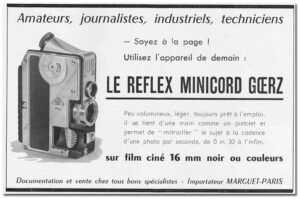
It was the Vienna branch which is relevant to this article, but sadly, I was able to find very little information about C.P. Goerz Vienna other than they existed. While the Berlin branch was more widely recognized as a lens maker, they did make some cameras, but they were primarily of the folding sheet and roll film type. Apart from a prototype 35mm camera called the Matonox made in the mid 1920s, Goerz was not known for miniature or subminiature cameras so it seems like a curious decision for the Austrian branch’s one and only camera to be a TLR subminiature camera that used double perforated 16mm film.

In what little information I could find, reports vary about the release of the Minicord between 1`950 and 1951, but I believe the later date to be accurate. The camera was exported all over Europe and even sold in the United States. In a short ad published in the June 1954 issue of Popular Science, the Minicord was sold by King Photo Import Co. Ltd. in New York City for $84.50 including a case. When adjusted for inflation, this price compares to just under $1000 today making it quite an investment for such a small camera.
In addition to the Minicord camera, a Minicord enlarger and film viewer which was designed to use the camera was also made and sold at the same time as the camera. This suggests that the 2.5cm f/2 Goerz Helgor produced images sharp enough to stand up to enlargement.
In a roundup of over 30 subminiature cameras in the October 1953 issue of Modern Photography is a short writeup of the Minicord. The text above is mostly just a summary of the camera’s features and less about its use. I could not find any contemporary reviews of the Minicord, but I have to suspect that it sold reasonably well, likely due to its very unique design and that nobody else made anything like it.

The Minicord would remain in production throughout the 1950s and in 1958, a revised Minicord III was released with additional flash coupling and different cosmetics. I am unsure of why there was never a camera marketed as the Minicord II however. The Minicord III is usually found with a brown leather body covering, but some gold plated examples have been found too. A few sites reference that some blue and red examples were made, but I have never seen images of one.
Today, there is a small but loyal group of collectors for subminiature cameras, and while a large number of cameras that fit this category are simple and inexpensive models, there are some gems, of which the Goerz Minicord would certainly qualify. Not many cameras of this size were made with the build quality and excellent lenses making this a highly collectible camera. That is is also one of a very small number of 16mm TLRs and the only postwar camera made in Austria by Goerz adds additional interest for collectors.
These cameras are not common, but they’re not exactly rare either. As I write this, a search for ‘Goerz Minicord’ on eBay returns 14 for sale, with prices starting at $195. If you are interested in one of the highest quality 16mm TLRs ever made, the Goerz Minicord is a great option and one that I would recommend collectors of any style of camera consider adding to your collection. I certainly did!
My Thoughts
The name Twin Lens Reflex refers to a style of camera popularized in the early to mid 20th century by the German company Franke & Heidecke, makers of the Rolleiflex, a very successful line of medium format TLRs which shoot 6cm x 6cm images on 120 format roll film. TLRs have come in many shapes and sizes before, a few folding models existed, there were some smaller ones that shot 4cm x 4cm images on 127 format roll film, a few that can do 6cm x 9cm images, and even a few that use 35mm.

Of all the TLRs that were made, most share a similar shape and general appearance. A tall rectangular body with two, usually symmetrical, lenses on the front give the TLR its name, but also the familiar inclusion of a waist level finder with folding hood, and usually some assortment of knobs or a film advance lever on the side.
A few TLRs like the Welta Perfekta and Superfekta veered from the typical design, as did the tiny Tessina, which was a 35mm TLR, but when it comes to 16mm film, there aren’t a lot of options.
The Goerz Minicord is a 16mm Twin Lens Reflex with a body that doesn’t at all resemble most other TLRs. Although slightly larger than the 35mm Tessina TLR, the Minicord has an upright body, with a fast Halgor 2.5cm f/2 lens, and an angled viewfinder that sticks out of the top. It has a folding handle which helps maintain a secure grip on the camera when in use, and it employs an ergonomically pleasant trigger film advance. The film itself is regular double perforated 16mm film, available for many motion picture cameras.
The Goerz Minicord is small, easily fitting into a dress shirt pocket or the front pocket of a set of jeans, but at 336 grams, is surprisingly heavy for its size. The build quality is excellent, feeling very much like a quality made camera. Small pieces of black leather cover parts of the body and in this example, were not peeling and still had a soft texture, giving the camera a bit of a luxurious feel. Very little space is wasted on the body as there isn’t a lot of real estate for the camera’s controls. Although not looking like any other camera ever made, the camera’s controls are all logically, and comfortably placed, so that when out shooting, having to change things like shutter speed or focus can be done with little effort.
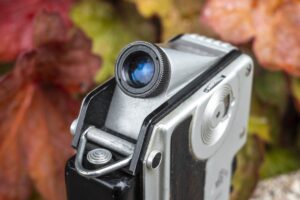
On top of the camera, you’ll see the Minicord’s distinct angled eye level viewfinder. Seeing through the viewfinder requires your eye to be pretty close to the eyepiece and since the viewfinder is not removable, there is no option for composing at waist level. Using an angled viewfinder is a strange experience, and one I’ve only ever experienced with an Alpa SLR. I didn’t care for that experience while shooting my Alpa Alnea Model 7, but the more compact size of the Minicord makes it feel slightly less awkward.
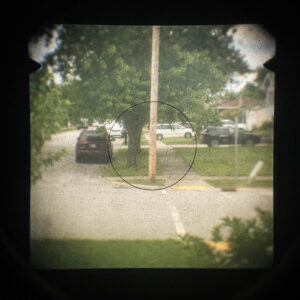
Looking through the viewfinder window, you see a reasonably large ground glass without any additional focus aides. A black circle in the middle indicates the area you should focus your image on. Although the whole ground glass can be used to “see” focus, optical distortions and heavy vignetting make it difficult to accurately focus near the edges of the ground glass. Two triangular notches near the upper left and right corners are parallax correction marks to be used when focusing the camera at distances of 1 meter and under. Around the eyepiece is an adjustable diopter, that when turned can bring the focus screen into sharp focus for people while wearing eyeglasses. I found this diopter adjustment to work quite well with my prescription, however with glasses on, it is impossible to see all four edges of the ground glass.
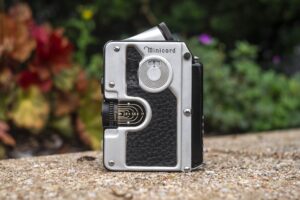
Turning the camera to the side with the Minicord logo on it, the first thing you see is the shutter speed selector. A curved window allows you to see the selected speed, which is changed by turning a dial via an exposed knurled edge on its left side. Available shutter speeds from 1/10 to 1/400 plus Bulb can be chosen. Although the wheel is small, I found turning the dial to be very easy and smooth. Below and to the left of the shutter speed selector is a depth of field scale for the focusing wheel which can be gripped on both sides of the camera. An indicator allows you to focus the lens from just under 0.4 meters to infinity with ease. The 2.5cm Goerz Helgor lens allows for good depth of field. With the lens set to f/11 and focused to 3 meters, everything from 1.5 meters to infinity will be in focus, allowing the Minicord to be used as a focus free camera for medium to faraway objects.
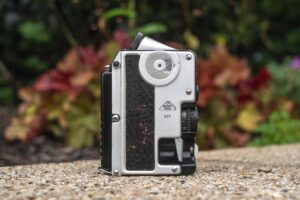
Flipping the camera over to the other side, we see the exposure counter with numbers from 0 to 42. The exposure counter is additive, showing how many were made on the current roll of film, and must be manually reset using a knurled wheel which sticks up through the top plate of the camera. A red arrow, two notches below 0 is the point where you must set the exposure counter after loading in a new piece of film. Advance two full exposures to reach 0 and then you may start shooting on your new roll of film. Near the bottom of this side is the film advance trigger. Simple squeeze the trigger until it stops moving and you’ve advanced the film one exposure, set the shutter, and advanced the exposure counter.
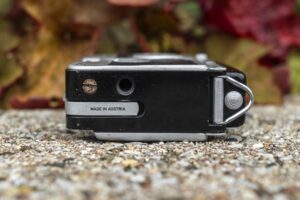
The base of the camera has a small folding handle which when extended, allows you to more securely grip the camera by holding it steady with your middle finger. Those with smaller hands may be able to rest two fingers on the grip, but for me, only one fits. Next to the folding handle is a threaded hole which doubles both as a tripod socket but also the flash sync port. A unique flash gun was made for the Goerz Minicord that screws into this hole, synchronizing the shutter to the flash at all speeds.
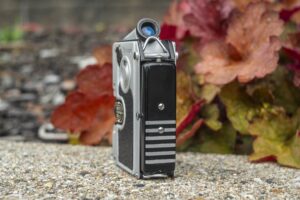
A removable metal cap, covering the film compartment occupies the entirety of the rear of the camera. To remove the cap, two metal posts on the top and bottom of the cover must be squeezed together while gently pulling the cap away from the camera. When it comes time to reinstall the cap, notches on both sides must be properly aligned with the body to prevent it from being installed upside down.

With the cap removed, inside you’ll see the tiny film gate flanked by two vertical channels which are used to advance the double perforated film. When squeezing the film advance trigger, two little fingers pop out and push the film from the supply side to the take up side. Film transports from bottom to top and cannot be rewound, which is very important to remember when loading film into the camera. The back of the cap has the film pressure plate, which like on most cameras, is spring loaded to maintain film flatness. The Minicord does not have any type of light seal, either foam or felt, so there is nothing to clean off and replace, although an inspection of the film compartment would be wise to prevent light leaks.
The Minicord originally came with two different styles of film magazines, a pair of identical metal cassettes for 25 exposures, and a special reloadable twin magazine for 40 exposures. The twin magazine is far less common as this Minicord, and most I’ve seen online have the 25 exposure cassettes. Both the supply and take up cassettes are identical and come out of the camera independently. When this camera was new, you could buy the 25 exposure cassettes with film preloaded and the way to tell the difference between an unexposed cassette and one that had been exposed, is that the unexposed leader would have 3 dots punched into the film, the tail would not.
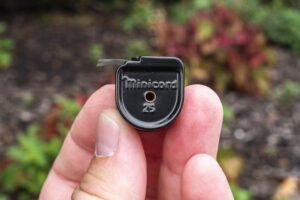
It has been decades since new Minicord film was sold, so if you want to shoot one, you must reload the cassettes. Although the 25 exposure cassettes were not intended to be reloaded, it can be done similarly to how AGFA Karat or Rapid film cassettes are by cutting a short strip of film, and feeding it back through the felt light trap into a cassette. When feeding film back into a Minicord cassette, it is important to keep the emulsion side (matte finish) facing away from the cassette, not toward it. Also, a strip of 25 exposures is about 14 inches long, and trying to force a strip longer than 14 inches will cause it to jam, so shorter is better.
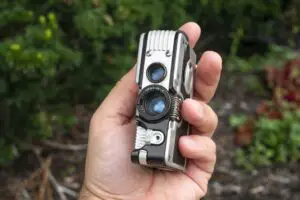
Up front, we see a smaller viewing lens and the main taking lens. The Goerz Minicord is a true TLR so the viewing and taking lenses are coupled. As you focus the taking lens, the viewing lens will rotate the same amount to correctly show focus in the viewfinder. On the inside of the taking lens is a small ring for controlling the aperture. Engraved into the ring are marks for f/2 through f/11. The aperture ring is quite small and fiddly to change. Those with large fingers will struggle with this, but then again, anyone with huge hands will likely struggle with the entire camera.
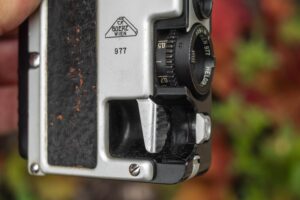
Below the taking lens is the cable threaded shutter release button. The location of this button is immediately next to the film advance tigger, so with the camera to your eye, your right index finger can conveniently move from the film advance to the shutter release with ease. A cable release can be used for Bulb exposures or a screw in self-timer as the camera lacks a built in self-timer.
The Goerz Minicord is a triumph of engineering and design. That every control of a full size TLR fits on the Minicord’s small body while still maintaining good ergonomics is a big deal as smaller cameras often make compromises in ergonomics. I also appreciated that Goerz avoided the temptation to automate exposure with complicated EV or LVS linkages or some kind of primitive form of auto exposure. Full manual control over the diaphragm and shutter speeds was the way to go, and that’s what they did.
The Minicord’s greatest strength is also its biggest weakness which is that it succeeded at bringing the features and usability of a full size TLR down to a camera which can use 16mm film, but that the market wasn’t immediately flooded with 16mm TLRs also suggests there wasn’t enough demand. The Minicord was produced for long enough to leave a legacy, a small legacy, but a legacy nonetheless.
My Results
Not having a lot of options when it comes to double perforated 16mm film to use in the Minicord, I turned to the great people at the Film Photography Project for some of their house brand 16mm motion picture film. I figured that as long as I had two empty Minicord cassettes (which I did), I could just hand load in some small strips of their film and shoot it as if it was made for the camera.
Looking through FPP’s store of movie film, I was surprised to see such a large variety of double perforated 16mm film to choose from. The company has black and white and color films, they have reversal and negative film stocks, and they have stuff with film speeds ranging from ISO 1 to 400. For me, I went with Cine 16 BW40 Reversal film. I intended on developing this using HC-110, so I’d get a negative image anyway, but what attracted me to it was its medium ISO 40 speed, but also that at $39.99 for 100 feet, it was the least expensive film I could try!
Whenever you shrink something down in size, there is always going to have to be compromises. This applies to all products, not just cameras. Whether performance takes a hit, capacity, usability, or if the price goes up, something has to come at the expense of size, for cameras however, it usually is performance.
Before I get to the Minicord’s results, I should spend a moment talking about developing the film from this camera. For those of you who home develop film, 16mm has its own challenges in that the film requires special reels which aren’t as easy to come by as 35mm and medium format reels.
A bulk of my developing is done with plastic Paterson reels, but for 16mm film (including 110), I use a stainless steel tank which loads differently. I’ve used both stainless and plastic reels for 35mm and 120 and although loading the metal reels usually isn’t harder in the larger formats, I find loading 16mm film onto the tiny reels to be a struggle. This alone, would discourage me from continuing to shoot the Minicord or other 16mm cameras, but I’ll do it for a review! Once loaded, developing is done like any other film but scanning can be an issue too as flatbed scanners usually do not have film holders for 16mm film. My solution for this is to sandwich the film between two pieces of glass and then scan it on the bed directly. This works but just requires extra effort, adding to the challenges of home developing 16mm film.
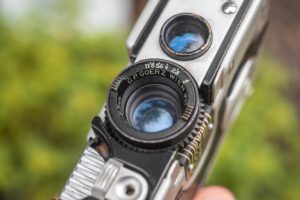
With the images on my computer, seeing the tiny 10mm x 10mm images blown up to fill the entirety of my 32″ monitor, I was amazed at the level of detail that the 6-element Goerz Helgor lens was able to capture. Certainly there was less detail than a medium format or even a 35mm TLR, but the images were easily superior to that of a lowly 110 film camera which exposes similar size images.
With only black and white film at my disposal, I obviously cannot comment on color accuracy, but the black and white images showed good contrast and even sharpness across the frame. The Minicord viewfinder previews the image with extremely soft edges and strong vignetting, but it is clear that these artifacts are limited to the viewing lens and not the taking lens. An enlarger was available at the time this camera was sold new, but I am unsure of how big people would blow up these images, but I suspect that prints up to 8 inches square could be made without a significant loss of detail.
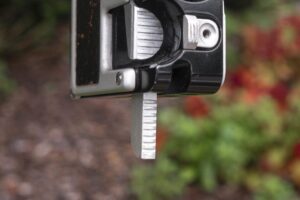
Any time you shrink a camera down and start to put controls in non-standard locations, you risk impeding the usability of the camera, but the designers of the Minicord definitely did their homework, making good choices for where things were located. That the camera could easily be gripped with your right hand while keeping your right index finger on both the shutter release and film advance, while freeing your left hand to change shutter speeds, f/stops, and focus the lens was smart. Since there is no exposure information visible in the viewfinder, you’d still need to lower the camera from your eye to see what settings you were changing, but not having to keep repositioning your hands in between each shot like you do on some TLRs (I am looking at you Rolleiflexes), is a definite plus.

While I can say a lot of nice things about the Minicord, I do have one nitpick, which is a fairly considerable one, and that is I wish there was a better way to use this camera without the viewfinder. Most full size TLRs have a sports or fast action finder allowing you to shoot objects far away in good lighting without having to use the viewfinder. The act of looking through the tiny angled viewfinder to see a dark image that’s only sharp in the center is not always ideal. It is fine for closeups or in low to medium light, but I feel as though using this camera in good lighting outdoors would have been more fun had I had the ability to frame my image and take a photo, alternating between the film advance and shutter release for rapid sequence shots without having to look through the viewfinder again.
One of the biggest appeals of small cameras is their portability and simplicity. I feel as though this camera could have benefitted from a way to make it more spontaneous and quick outdoors. Certainly, the viewfinder is probably as good as you could have made it within the parameters of the design, but I question whether it was necessary at all.
That said, for what it is, the Goerz Minicord is a heck of a camera. That so many things could be shrunk down to this form factor and work as well as they do, while delivering very sharp and contrasty tiny images is awesome. That there was little to no competition in the 16mm TLR market suggests that there wasn’t much demand for this camera and I can see why, but for the times that a 16mm TLR is something you need, there isn’t anything better!
Related Posts You Might Enjoy
External Links
http://camera-wiki.org/wiki/Minicord
https://www.pacificrimcamera.com/pp/goerzminicord.htm
https://beyondtheaperture.com/2022/11/how-to-cut-and-load-film-for-the-goerz-minicord/
https://www.collection-appareils.fr/x/html/page_standard.php?id_appareil=10981
https://www.photo.net/forums/topic/528780-goerz-minicord/
https://cameracollector.net/goerz-minicord-iii/
https://web.archive.org/web/20180504131820/http://www.ukcamera.com/classic_cameras/goerz1.htm (Archived)

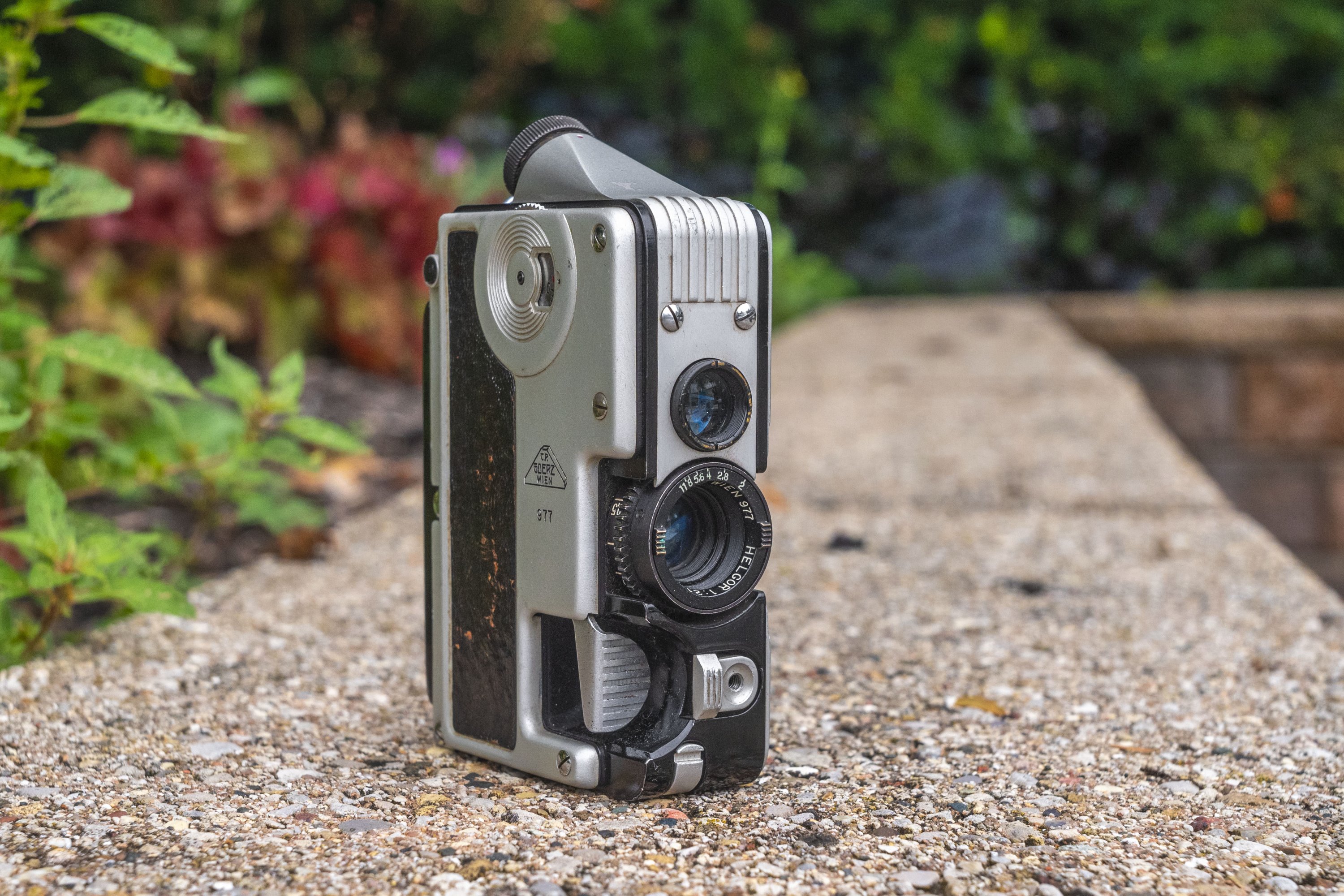
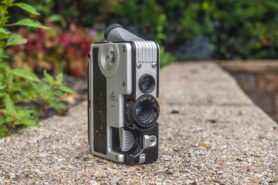
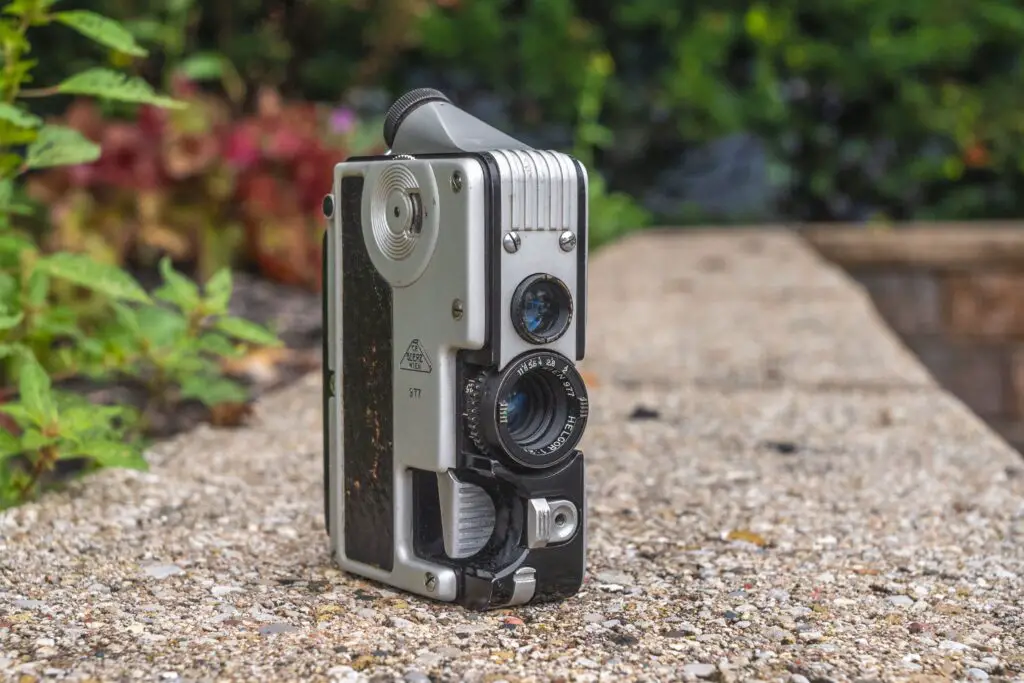
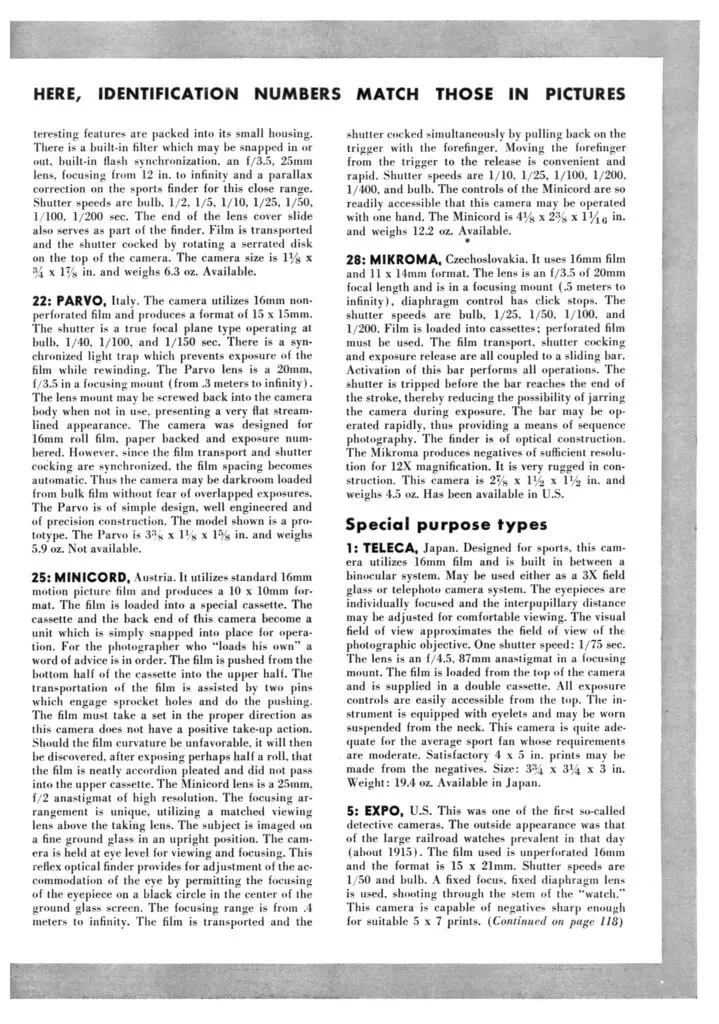











Great review and a cool camera. As far as developing, I got two inexpensive 110/16mm reels (Patterson compatible) from film stuff labs on Etsy and they work great. I use a Lomo 110/16mm film holder on my flatbed scanner. Between the two they make it quite easy to do 110/16 mm
I would invest in some 16mm Paterson reels, but I shoot so little 16mm film, the few times I need to develop it, the small stainless tank works good enough. It is good to know that there are other options out there though.